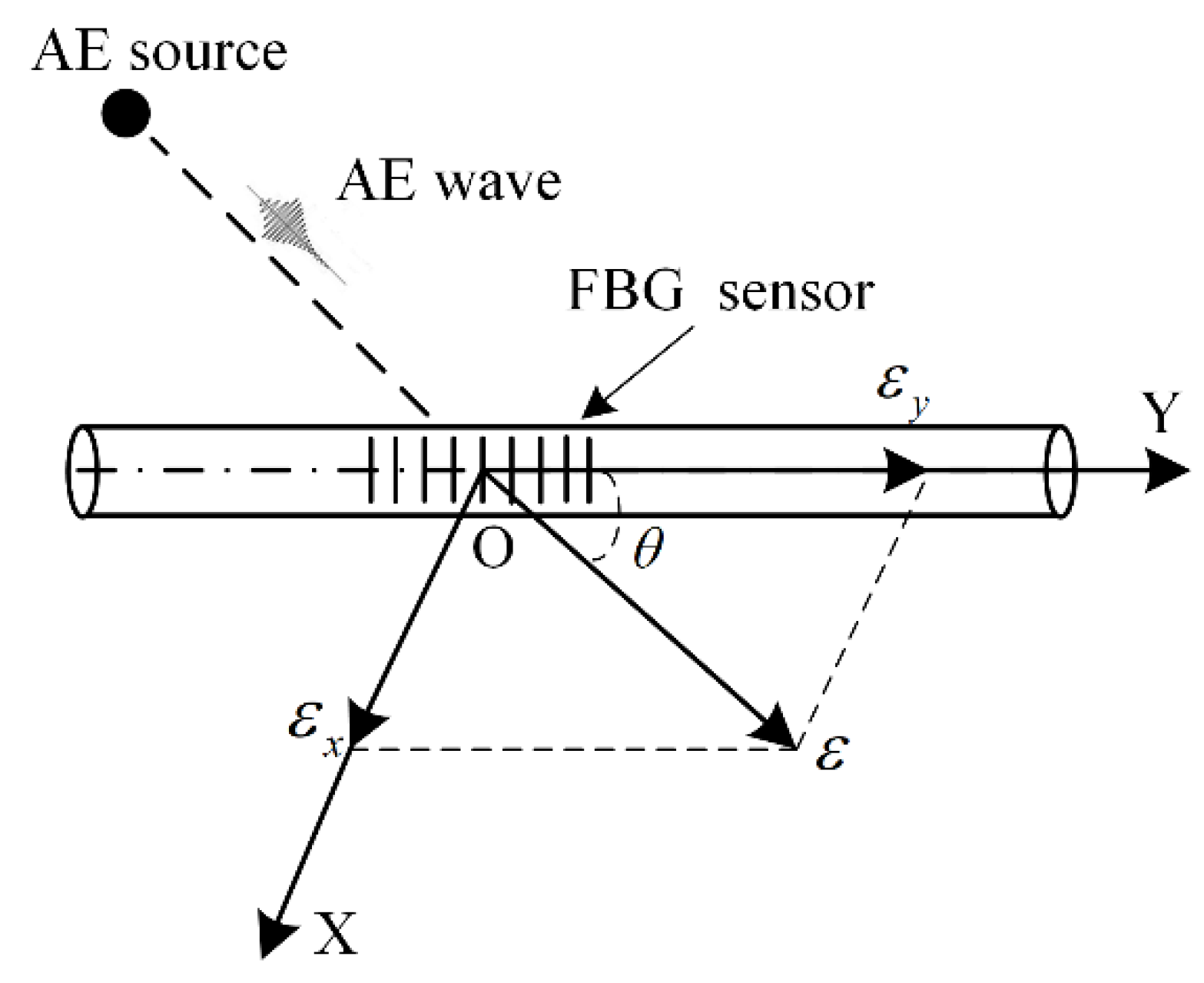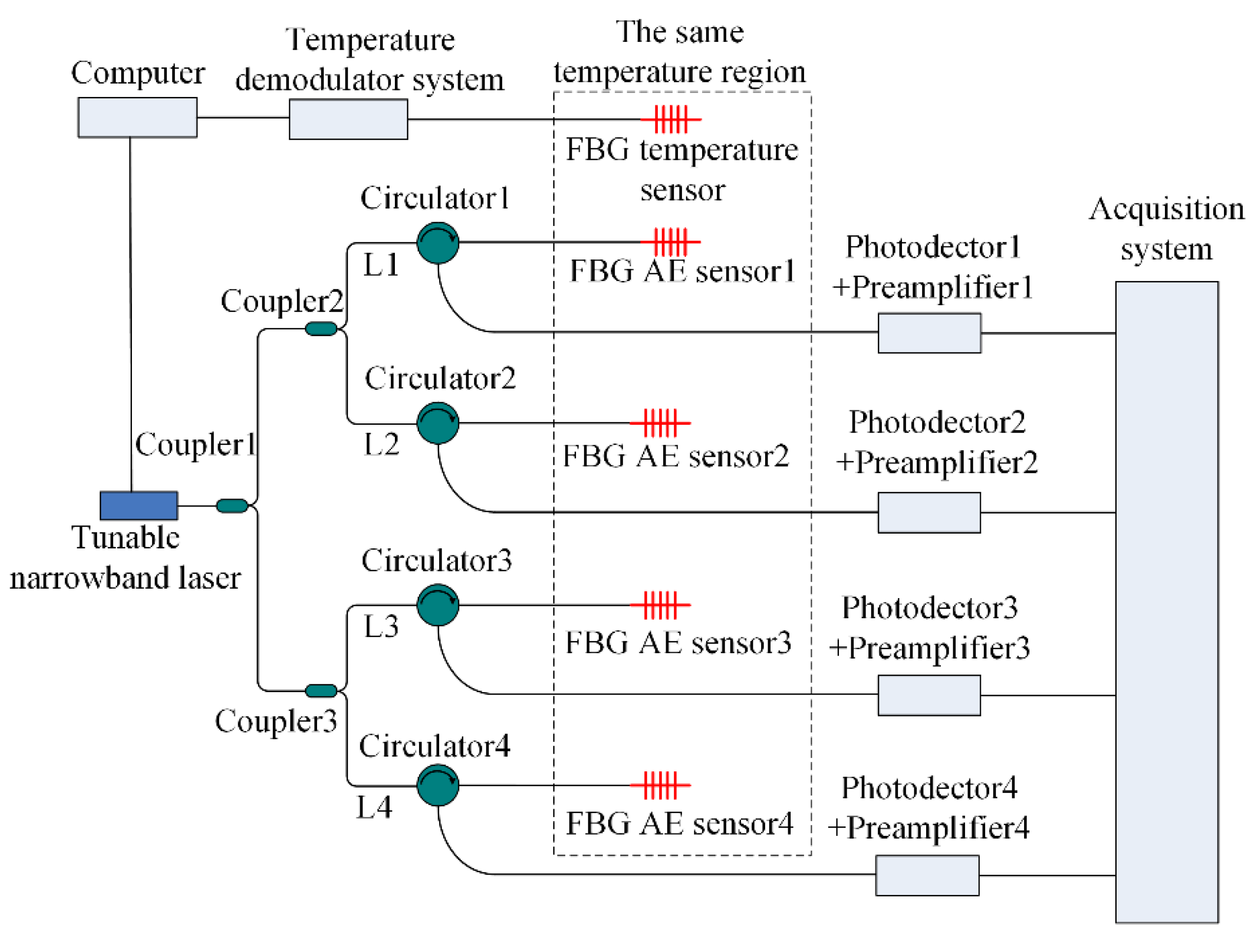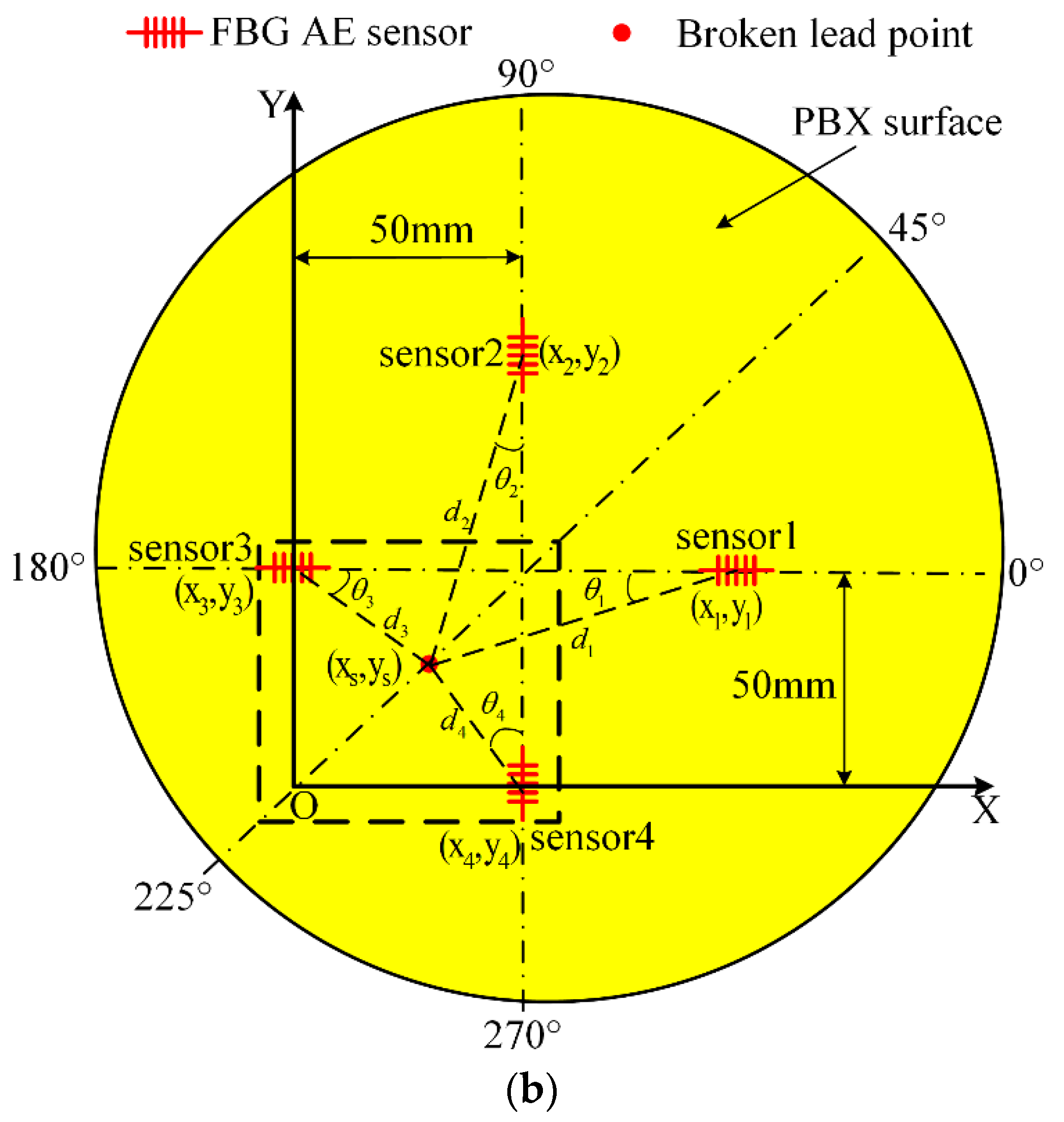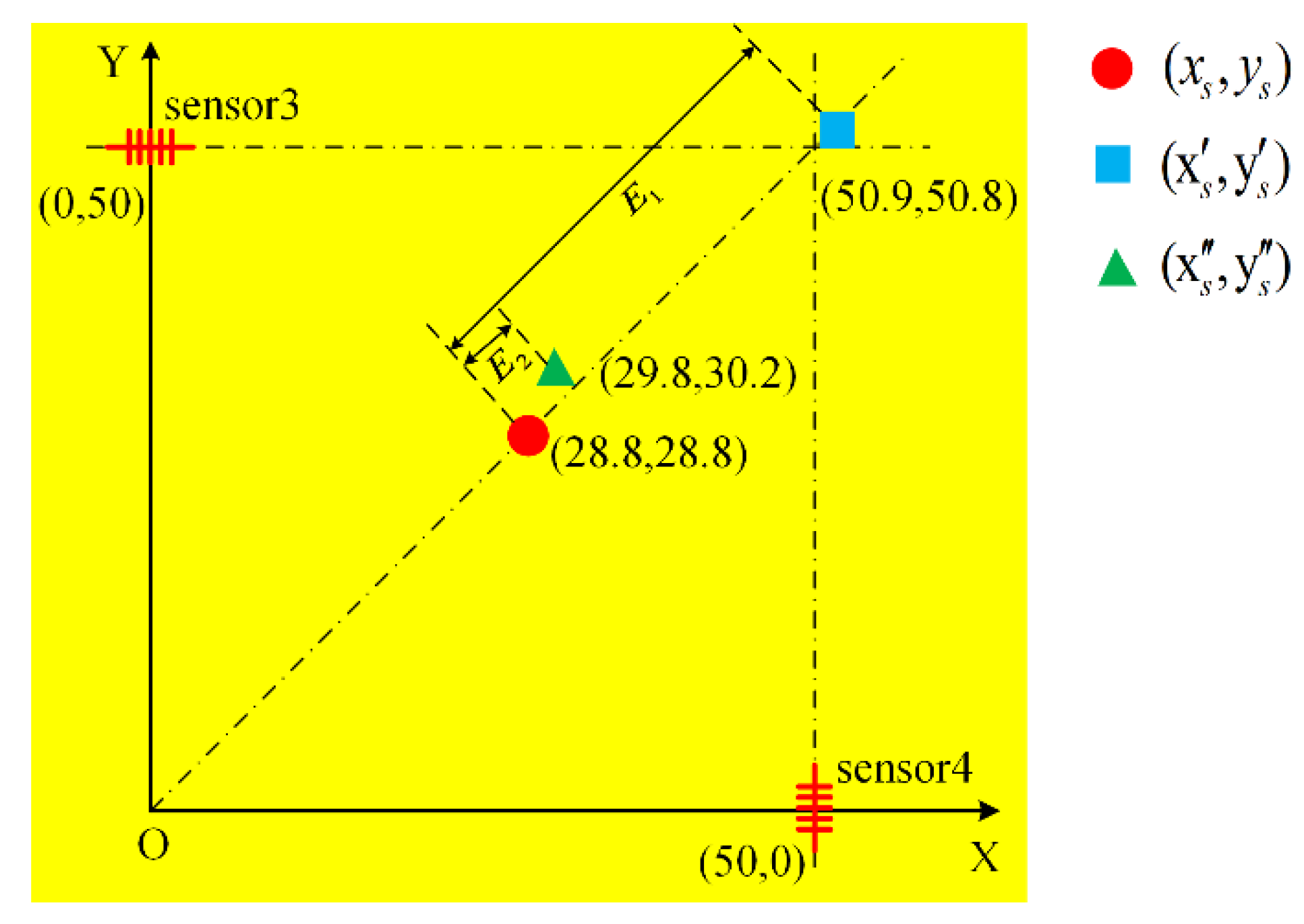Application of Fiber Bragg Grating Acoustic Emission Sensors in Thin Polymer-Bonded Explosives
Abstract
1. Introduction
2. Directionality of the FBG Sensor
3. Experiments and Results
3.1. Experimental Device
3.2. FBG AE Sensor Directionality Experiment
3.3. AE Source Location Experiment on a Thin PBX Sample
4. Summary and Conclusions
Author Contributions
Funding
Acknowledgments
Conflicts of Interest
Abbreviations
| AE | acoustic emission |
| PBX | polymer bonded explosives |
| PZT | piezoelectric |
| FBG | fiber Bragg grating |
References
- Shen, G.T. Acoustic Emission Technology and Application, 1st ed.; Science Press: Beijing, China, 2015; pp. 1–5. ISBN 978-7-03-044522-3. [Google Scholar]
- Garcia-Souto, J.A.; Lamela-River, H. High resolution (<1 nm) interferometric fiber-optic sensor of vibrations in high-power transformers(. Opt. Express 2006, 14, 9679–9686. [Google Scholar] [CrossRef] [PubMed]
- Lee, B. Review of Present Status of Optical Fiber Sensors. Opt. Fiber Technol. 2003, 9, 57–79. [Google Scholar] [CrossRef]
- Bao, X.Y.; Chen, L. Recent progress in distributed fiber optic sensors. Sensors 2012, 12, 8601–8639. [Google Scholar] [CrossRef] [PubMed]
- Tosi, D.; Schena, E.; Molardi, C.; Korganbayev, S. Fiber optic sensors for sub-centimeter spatially resolved measurements: Review and biomedical applications. Opt. Fiber Technol. 2018, 43, 6–19. [Google Scholar] [CrossRef]
- Chen, J.J.; Liu, B.; Zhang, H. Review of fiber Bragg grating sensor technology. Front. Optoelectron. China 2011, 4, 204–212. [Google Scholar] [CrossRef]
- De Oliveira, R.; Ramos, C.A.; Marques, A.T. Health monitoring of composite structures by embedded FBG and interferometric Fabry–Perot sensors. Comput. Struct. 2008, 86, 340–346. [Google Scholar] [CrossRef]
- Posada-Roman, J.; Garcia-Souto, J.A.; Rubio-Serrano, J. Fiber-optic Sensor for Acoustic Detection of Partial Discharges in Oil-Paper Insulated Electrical Systems. Sensors 2012, 12, 4793–4801. [Google Scholar] [CrossRef] [PubMed]
- Garcia-Souto, J.A.; Posada, J.E.; Serrano, J.R. All-fiber intrinsic sensor of partial discharge acoustic emission with electronic resonance at 150 kHz. Proc. SPIE Opt. Sens. Detect. 2010, 7226, 1–7. [Google Scholar] [CrossRef]
- Wei, P.; Han, X.L.; Xia, D. A Measurement Method for the Velocity of Acoustic Emission Wave in Liquid Nitrogen. IEEE Trans. Ind. Electron. 2018, 65, 8232–8238. [Google Scholar] [CrossRef]
- Wei, P.; Han, X.L.; Xia, D.; Liu, T.L.; Lang, H. Novel Fiber-Optic Ring Acoustic Emission Sensor. Sensors 2018, 18, 215. [Google Scholar] [CrossRef]
- Chen, R.; Theobald, P.; Gower, M. A novel fibre optic acoustic emission sensor. In Proceedings of the SPIE, San Diego, CA, USA, 10–12 March 2008; pp. 1–12. [Google Scholar]
- Fu, T.; Liu, Y.J.; Lau, K.T.; Leng, J.S. Impact source identification in a carbon fiber reinforced polymer plate by using embedded fiber optic acoustic emission sensors. Compos. Part B 2014, 66, 420–429. [Google Scholar] [CrossRef]
- Yu, F.; Okabe, Y. Fiber-Optic Sensor-Based Remote Acoustic Emission Measurement in a 1000 °C Environment. Sensors 2017, 17, 2908. [Google Scholar] [CrossRef]
- Li, W.; Xu, C.; Ho, S.C.M.; Wang, B.; Song, G. Monitoring Concrete Deterioration Due to Reinforcement Corrosion by Integrating Acoustic Emission and FBG Strain Measurements. Sensors 2017, 17, 657. [Google Scholar] [CrossRef] [PubMed]
- Wu, Q.; Okabe, Y. High-sensitivity ultrasonic phase-shifted fiber Bragg grating balanced sensing system. Opt. Express 2012, 20, 28353–28362. [Google Scholar] [CrossRef] [PubMed]
- Tsuda, H.; Kumakura, K.; Ogihara, S. Ultrasonic Sensitivity of Strain-Insensitive Fiber Bragg Grating Sensors and Evaluation of Ultrasound-Induced Strain. Sensors 2010, 10, 11248–11258. [Google Scholar] [CrossRef] [PubMed]
- Li, Z.X.; Pei, L.; Dong, B.; Ma, C.; Wang, A.B. Analysis of ultrasonic frequency response of surface attached fiber Bragg grating. Appl. Opt. 2012, 51, 4709–4714. [Google Scholar] [CrossRef] [PubMed]
- Perez, I.M.; Cui, H.L.; Udd, E. Acoustic emission detection using fiber Bragg gratings. In Proceedings of the SPIE—Smart Structures and Materials, Newport Beach, CA, USA, 6 August 2001; Volume 4328, pp. 209–235. [Google Scholar]
- Duff, A.L.; Hamdi, S.E.; Plantier, G.; Lascoup, B. Time delay estimation for acoustic source location by means of short-time cross-correlation. In Proceedings of the IEEE Sensors, Limerick, Ireland, 28–31 October 2011; pp. 1885–1888. [Google Scholar]
- Yang, D.; Wang, S.; Lu, P.; Liu, D.M. Dual fiber Bragg gratings configuration-based fiber acoustic sensor for low-frequency signal detection. In Proceedings of the SPIE/COS Photonics Asia, Beijing, China, 9–11 October 2014; Volume 9274, pp. 1–8. [Google Scholar]
- Zhao, Y. Optical Fiber Grating and Sensing Technology, 1st ed.; National Defense Industry Press: Beijing, China, 2007; pp. 23–26. ISBN 7-118-04871-2. [Google Scholar]
- Wu, Q.; Okabe, Y.; Saito, K.; Yu, F. Sensitivity distribution properties of a phase-shifted fiber bragg grating sensor to ultrasonic waves. Sensors 2014, 14, 1094–1105. [Google Scholar] [CrossRef] [PubMed]
- Rosenthal, A.; Razansky, D.; Ntziachristos, V. High-sensitivity compact ultrasonic detector based on a pi-phase-shifted fiber Bragg grating. Opt. Lett. 2011, 36, 1833–1835. [Google Scholar] [CrossRef] [PubMed]
- Falcetelli, F.; Romero, M.B.; Pant, S.; Troiani, E.; Martinez, M. Modelling of Pencil-Lead Break Acoustic Emission Sources using the Time Reversal Technique. In Proceedings of the 9th European Workshop on Structural Health Monitoring, Manchester, UK, 10–13 July 2018; pp. 1–13. [Google Scholar]
- Innes, M.; Davisa, C.; Rosalie, C.; Norman, P.; Rajic, N. Acoustic Emission Detection and Characterisation Using Networked FBG Sensors. Procedia Eng. 2017, 188, 440–447. [Google Scholar] [CrossRef]
- Yang, M.W. Acoustic Emission Detection, 1st ed.; China Machine Press: Beijing, China, 2010; pp. 18–21. ISBN 978-7-111-15772-4. [Google Scholar]













| Angle θ | Arrival Time T/μs |
|---|---|
| 0° | 2.30 |
| 10° | 2.40 |
| 20° | 2.60 |
| 30° | 2.65 |
| 40° | 2.90 |
| 50° | 3.55 |
| 60° | 4.20 |
| 70° | 5.40 |
| 80° | 6.20 |
| 90° | 8.50 |
| Experiment Locations | T1/ms | T2/ms | T3/ms | T4/ms |
|---|---|---|---|---|
| No. 1 | 0.3360 | 0.3365 | 0.3380 | 0.3373 |
| No. 2 | 0.2065 | 0.2080 | 0.1890 | 0.1875 |
| No. 3 | 0.4750 | 0.4755 | 0.4660 | 0.4653 |
| No. 4 | 0.3602 | 0.3700 | 0.3505 | 0.3703 |
| No. 5 | 0.2505 | 0.2680 | 0.2365 | 0.2665 |
| No. 6 | 0.3468 | 0.3790 | 0.3003 | 0.3770 |
| Experiment Locations | /mm | /mm | E1 /mm | /mm | E2 /mm |
|---|---|---|---|---|---|
| No. 1 | (28.8,28.8) | (50.9,50.8) | 31.2 | (29.8,30.2) | 1.7 |
| No. 2 | (35.9,35.9) | (39.8,38.0) | 4.5 | (35.0,36.6) | 1.2 |
| No. 3 | (42.9,42.9) | (44.9,44.4) | 2.5 | (44.3,43.9) | 1.7 |
| No. 4 | (40.0,50.0) | (49.5,50.0) | 9.5 | (39.5,48.7) | 1.4 |
| No. 5 | (30.0,50.0) | (48.8,47.0) | 19.0 | (29.7,48.4) | 1.7 |
| No. 6 | (20.0,50.0) | (70.4,71.7) | 55.0 | (21.2,49.5) | 1.3 |
© 2018 by the authors. Licensee MDPI, Basel, Switzerland. This article is an open access article distributed under the terms and conditions of the Creative Commons Attribution (CC BY) license (http://creativecommons.org/licenses/by/4.0/).
Share and Cite
Fu, T.; Wei, P.; Han, X.; Liu, Q. Application of Fiber Bragg Grating Acoustic Emission Sensors in Thin Polymer-Bonded Explosives. Sensors 2018, 18, 3778. https://doi.org/10.3390/s18113778
Fu T, Wei P, Han X, Liu Q. Application of Fiber Bragg Grating Acoustic Emission Sensors in Thin Polymer-Bonded Explosives. Sensors. 2018; 18(11):3778. https://doi.org/10.3390/s18113778
Chicago/Turabian StyleFu, Tao, Peng Wei, Xiaole Han, and Qingbo Liu. 2018. "Application of Fiber Bragg Grating Acoustic Emission Sensors in Thin Polymer-Bonded Explosives" Sensors 18, no. 11: 3778. https://doi.org/10.3390/s18113778
APA StyleFu, T., Wei, P., Han, X., & Liu, Q. (2018). Application of Fiber Bragg Grating Acoustic Emission Sensors in Thin Polymer-Bonded Explosives. Sensors, 18(11), 3778. https://doi.org/10.3390/s18113778





